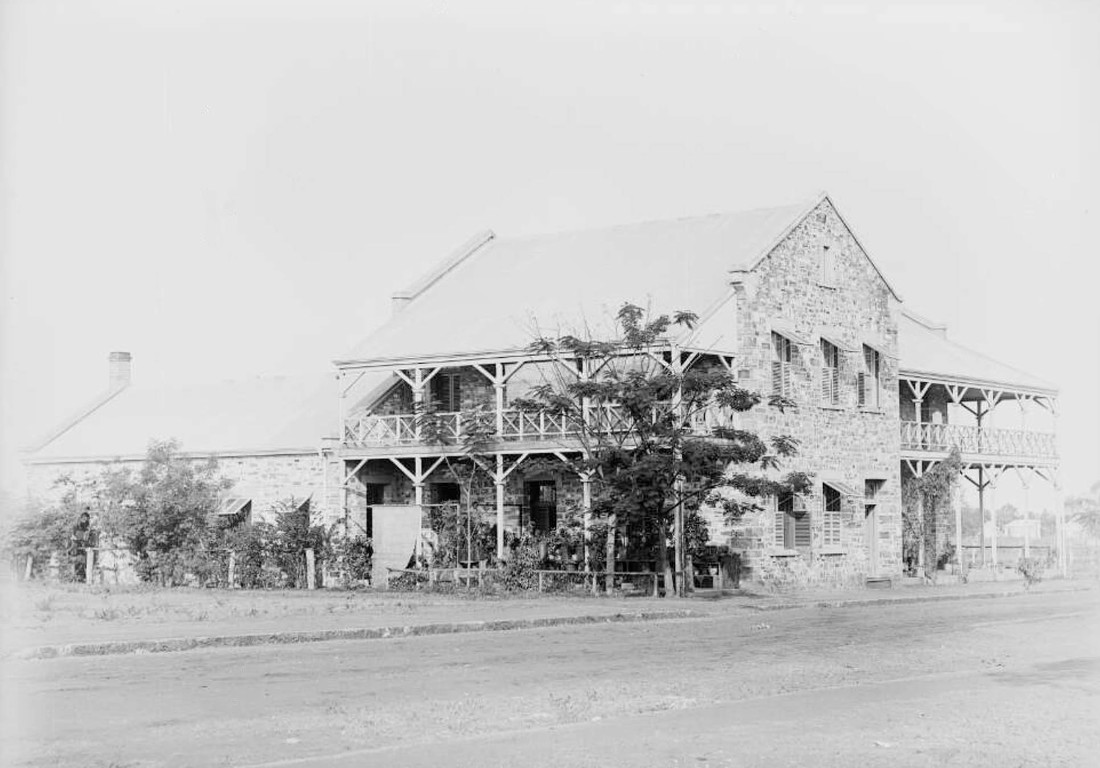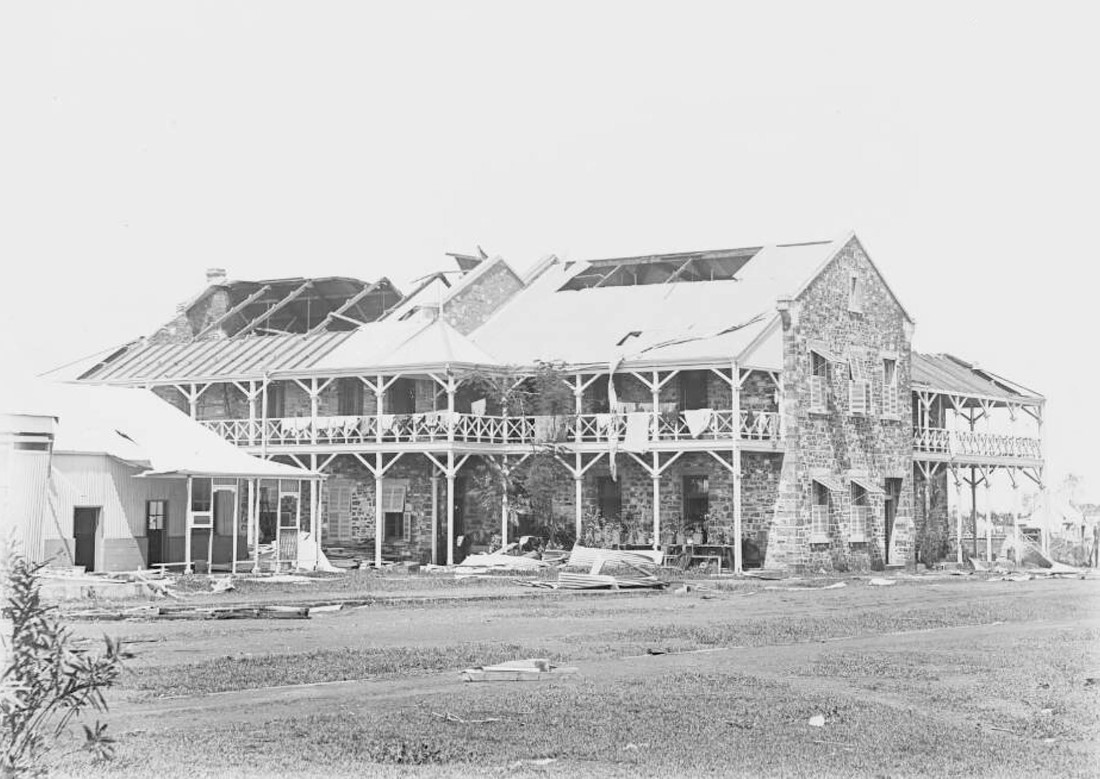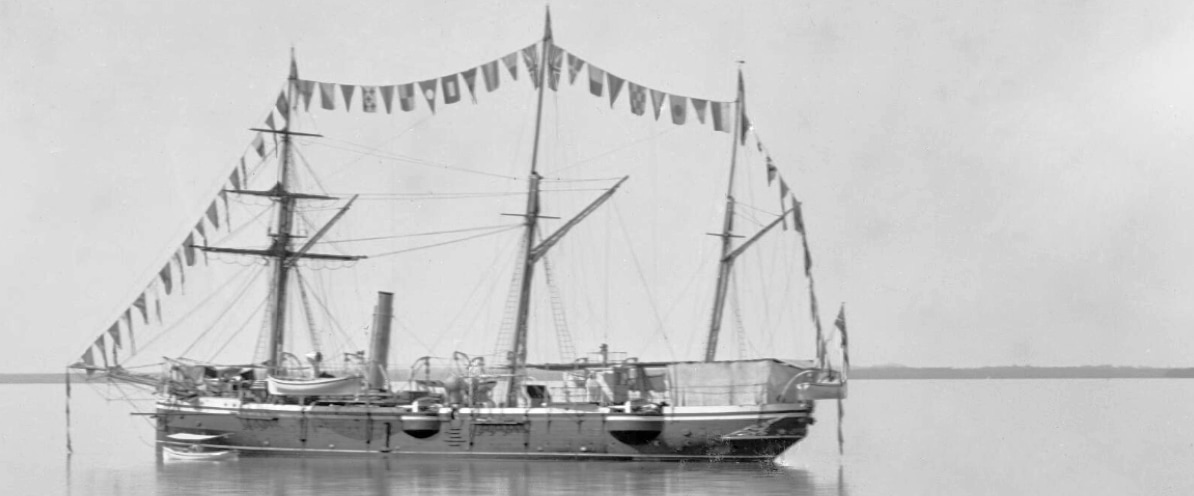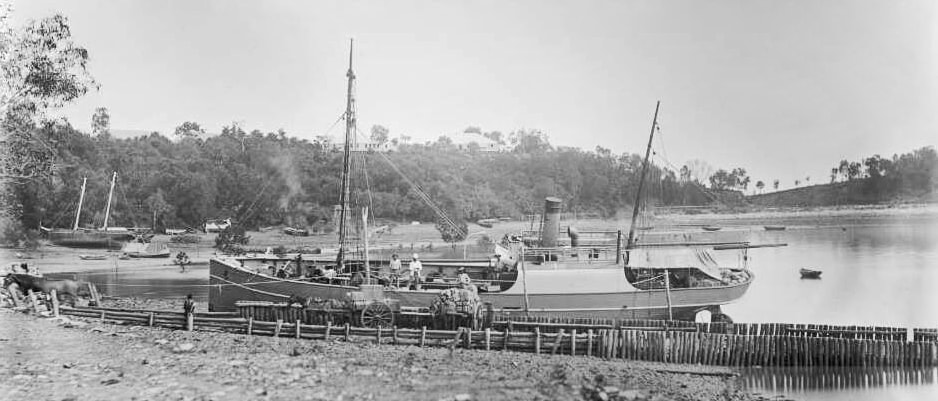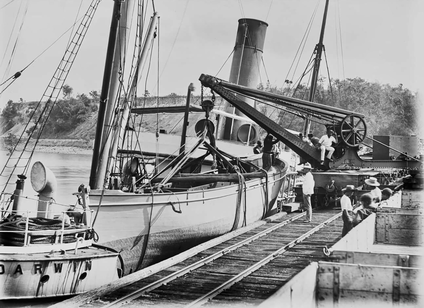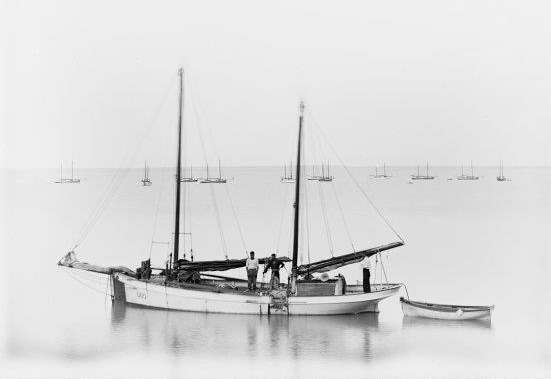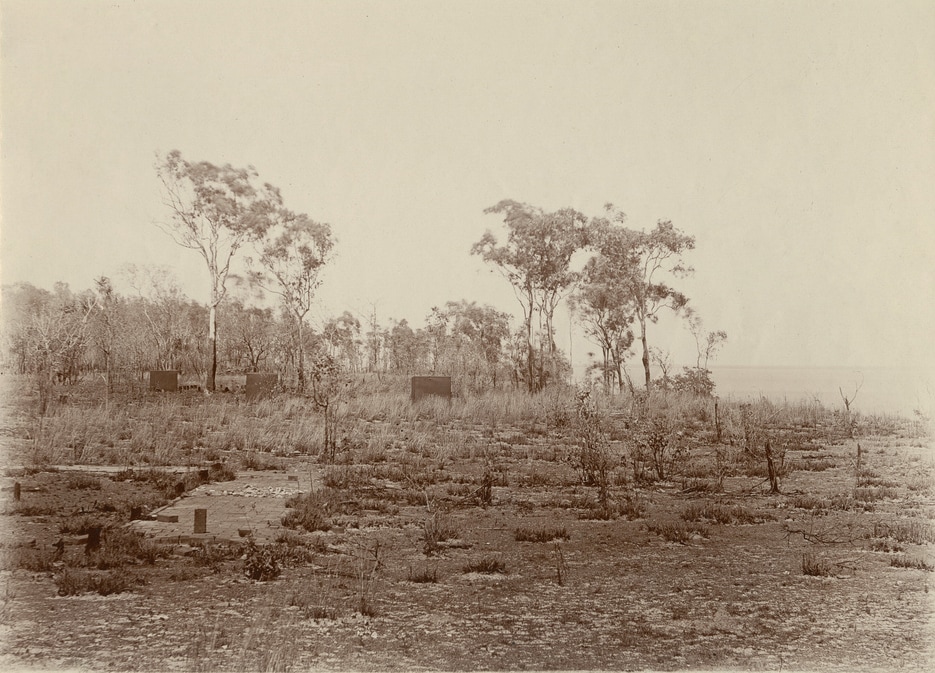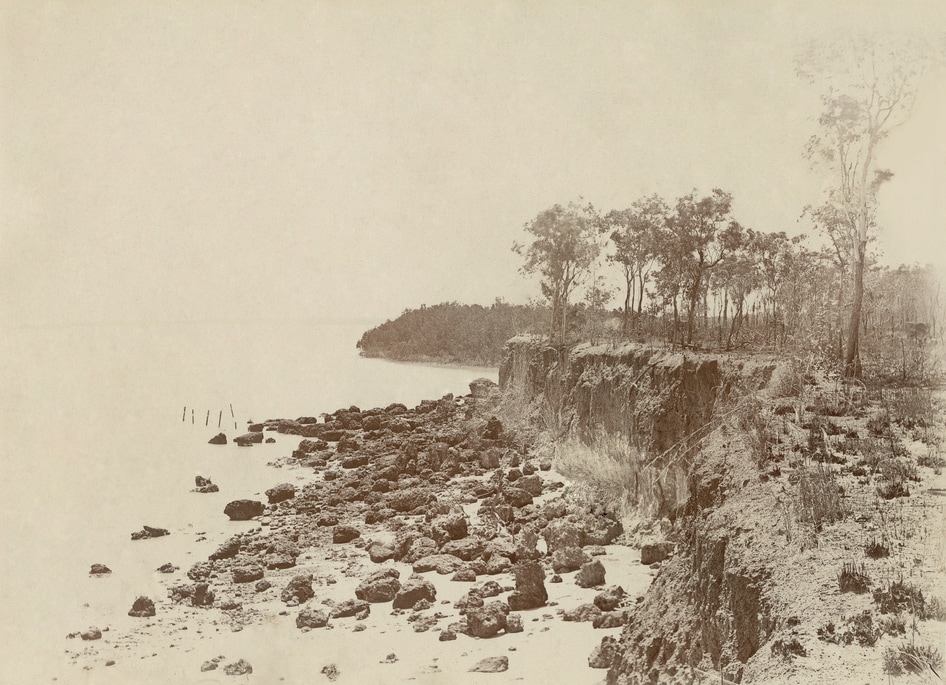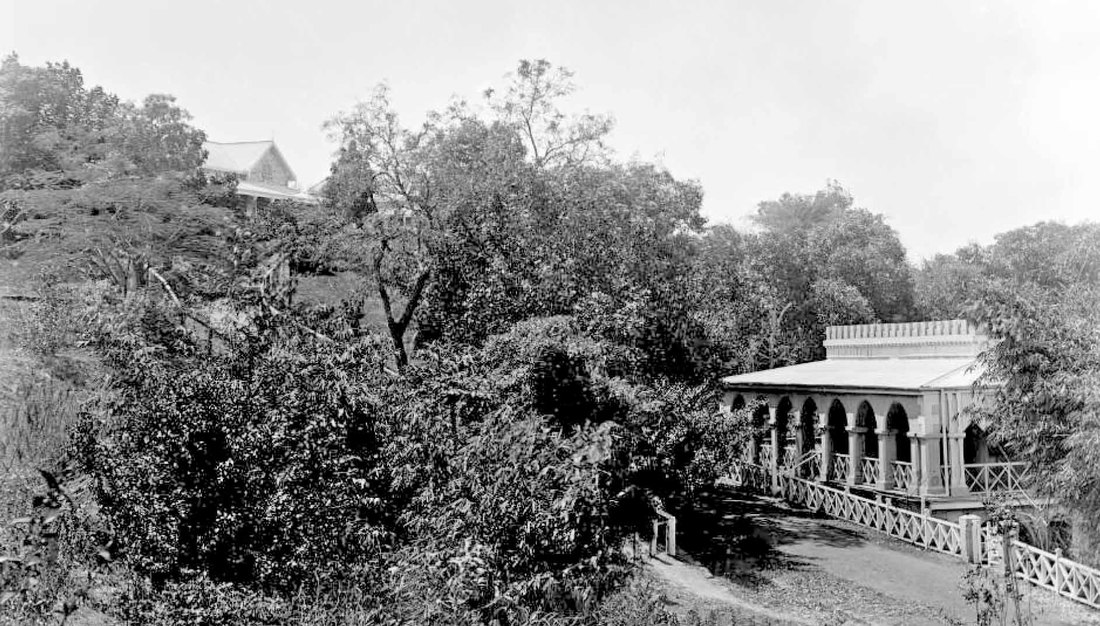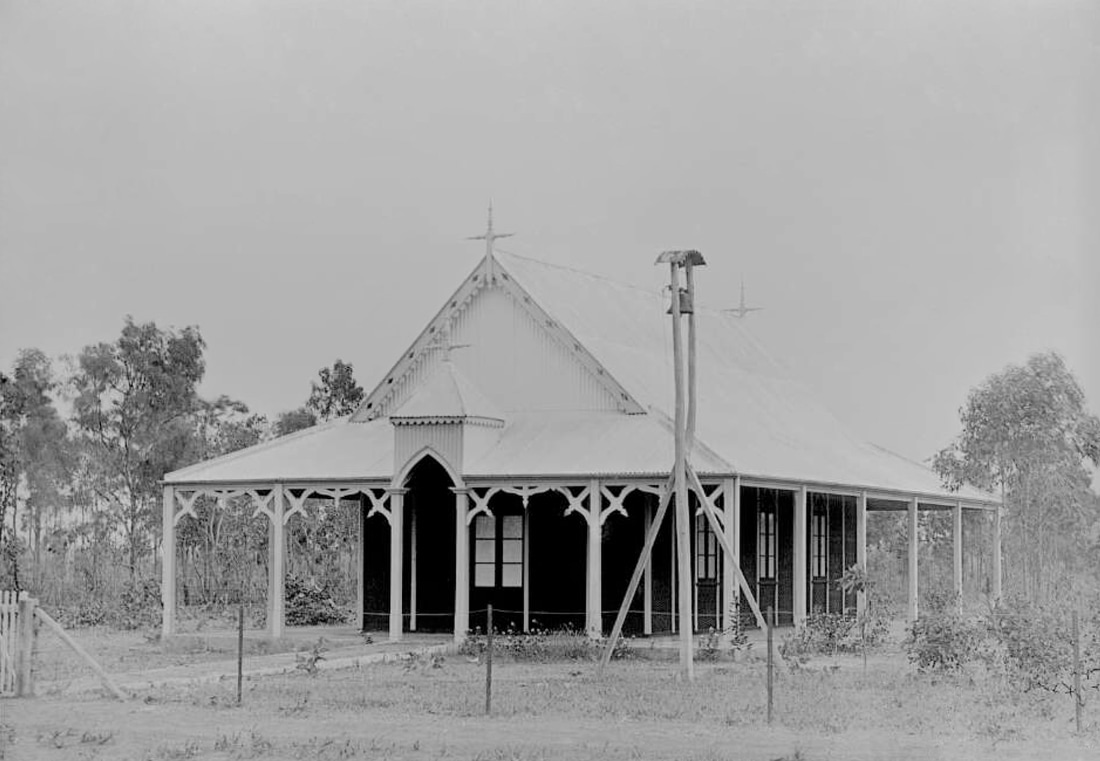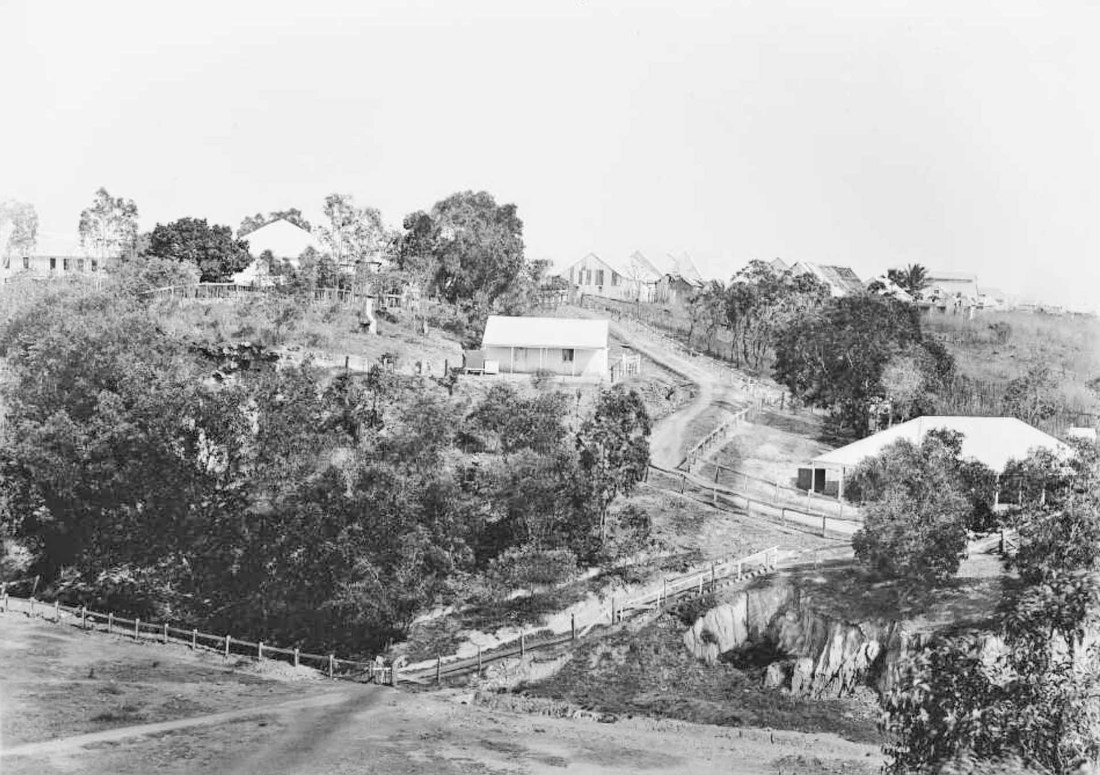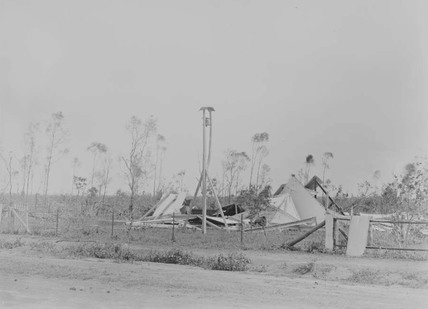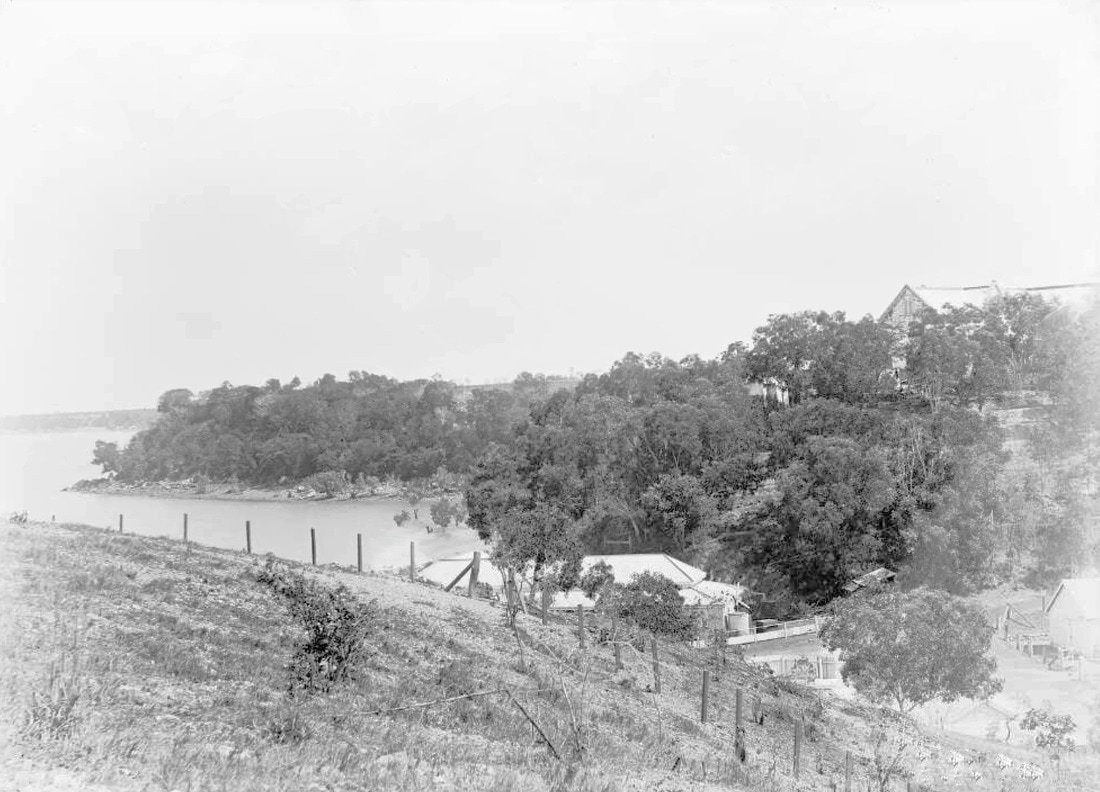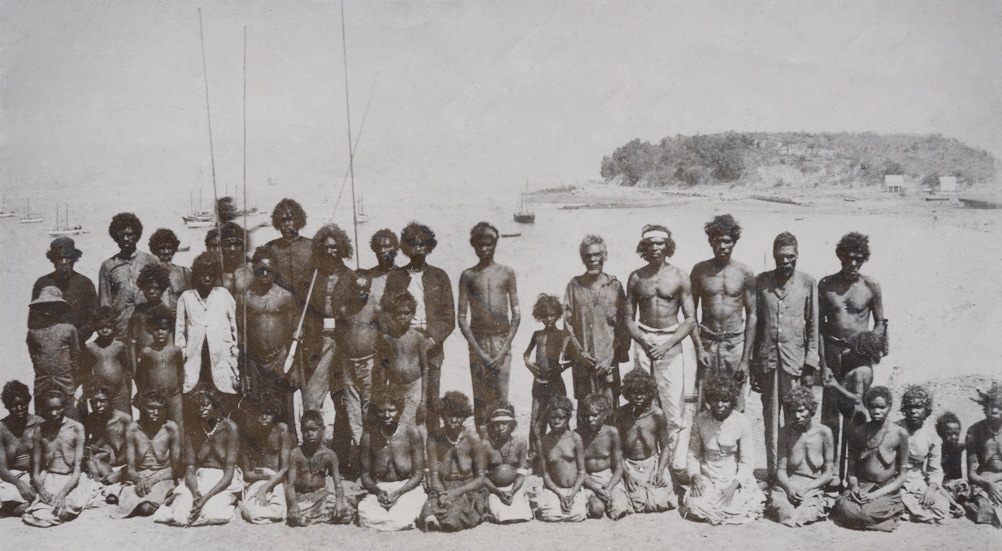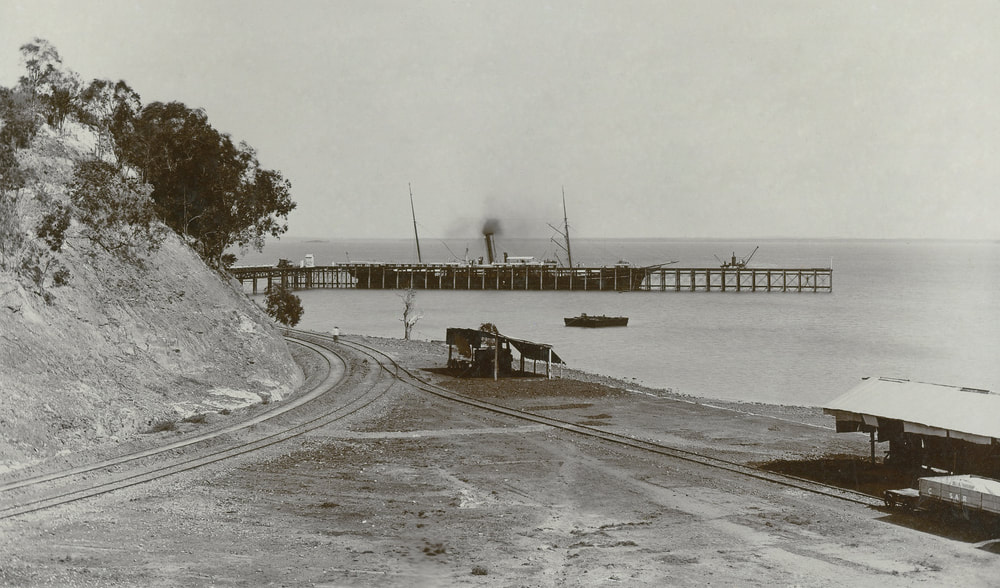Under Construction - Territory Fast Tracking
EARLY NT PHOTOGRAPHERS & ARTISTS
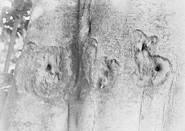 Port Darwin tree blazed 1866
Port Darwin tree blazed 1866
The NT has been fortunate to host some of the finest artists (Westal), cartographers (Flinders & Roe) and photographers, going back to Hamilton & Hake at Escape Cliffs in 1866. It was the immediate precursor to settlement at Port Darwin which has been photographed throughout it's entire history.
The names of Captain Sweet and Inspector Paul Foelsche are paramount but a tendency to allot any early image to these two has diminished other valuable contributions from such as Florenz Bleeser. In the interim many Sweet & Foelsche images are presented on the Beagle Cove page.
The names of Captain Sweet and Inspector Paul Foelsche are paramount but a tendency to allot any early image to these two has diminished other valuable contributions from such as Florenz Bleeser. In the interim many Sweet & Foelsche images are presented on the Beagle Cove page.
Florenz August Karl Bleeser (1871 - 1942)
Florenz August Karl Bleeser (1871 - 1942) worked at the Telegraph Office. He was a celebrated botanist and as a photographer he had a range of interests including ships & young Larrakia women. He captured some of the most insightful images of Darwin around the turn of the 20th century. He is best known for his graphic record of the 1897 cyclone.
Biography
Born at Woodside, in the Adelaide Hills, S.A., on 5 July 1871 and died at Malvern, Adelaide on 1 November 1942.
Appointed to the staff of the Australian Post Office on 1 September 1884; in 1889 he was promoted and transferred to Darwin where he was later Assistant Postmaster. For the rest of his working life, he remained in Darwin and besides making valuable plant collections, he and his wife also entertained and assisted visiting scientists. After the first air raid on Darwin in February 1942 he and his wife were evacuated to Adelaide.
Possibly influenced by his father who, as a very young man, is reported to have accompanied the botanist Dr R. M. Schomburgk on journeys in British Guiana 1840-44, Bleeser began making botanical collections soon after being posted to Darwin. He sent plant material to Kew, the National Herbarium in Melbourne, the Berlin Herbarium and some specimens to Blakely, in Sydney. Unfortunately, the material sent to Berlin has been reported to have been destroyed, whilst all his natural history collections and the bush-house of orchids which he had to leave behind in Darwin were also destroyed by looters.
One writer expressed the opinion that Bleeser would have made his greatest contribution in a science laboratory, since he had added more than any other man (at that time) to the natural history around Darwin. Apart from the eucalypt (E. bleeseri Blakely (1927) ), Bleeser was commemorated by at least one orchid and two grasses being named after him.
Source: Hall, N. (1978) Botanists of the Eucalypts. CSIRO, Melbourne.
In 1927 Otto Schwarz described 43 new taxa from his specimens from the Darwin area. Specimens (numbered) at K, MEL (donation rec. 1928-29), NSW (and B but probably destroyed there in 1943); his private collection in Darwin also destroyed after he left.
Commemorated in Alectryon, Chilochista, Eragrostis, Eriachne, Eucalyptus, Eugenia, Ptychosperma
Source: George, A.S. (2009) Australian Botanist's Companion, Four Gables Press, WA. [consult for source references]
Australian National Herbarium - updated 29 October, 2013 by webmaster ([email protected])
Born at Woodside, in the Adelaide Hills, S.A., on 5 July 1871 and died at Malvern, Adelaide on 1 November 1942.
Appointed to the staff of the Australian Post Office on 1 September 1884; in 1889 he was promoted and transferred to Darwin where he was later Assistant Postmaster. For the rest of his working life, he remained in Darwin and besides making valuable plant collections, he and his wife also entertained and assisted visiting scientists. After the first air raid on Darwin in February 1942 he and his wife were evacuated to Adelaide.
Possibly influenced by his father who, as a very young man, is reported to have accompanied the botanist Dr R. M. Schomburgk on journeys in British Guiana 1840-44, Bleeser began making botanical collections soon after being posted to Darwin. He sent plant material to Kew, the National Herbarium in Melbourne, the Berlin Herbarium and some specimens to Blakely, in Sydney. Unfortunately, the material sent to Berlin has been reported to have been destroyed, whilst all his natural history collections and the bush-house of orchids which he had to leave behind in Darwin were also destroyed by looters.
One writer expressed the opinion that Bleeser would have made his greatest contribution in a science laboratory, since he had added more than any other man (at that time) to the natural history around Darwin. Apart from the eucalypt (E. bleeseri Blakely (1927) ), Bleeser was commemorated by at least one orchid and two grasses being named after him.
Source: Hall, N. (1978) Botanists of the Eucalypts. CSIRO, Melbourne.
In 1927 Otto Schwarz described 43 new taxa from his specimens from the Darwin area. Specimens (numbered) at K, MEL (donation rec. 1928-29), NSW (and B but probably destroyed there in 1943); his private collection in Darwin also destroyed after he left.
Commemorated in Alectryon, Chilochista, Eragrostis, Eriachne, Eucalyptus, Eugenia, Ptychosperma
Source: George, A.S. (2009) Australian Botanist's Companion, Four Gables Press, WA. [consult for source references]
Australian National Herbarium - updated 29 October, 2013 by webmaster ([email protected])
“Florenz Bleeser owned a store in Darwin but was well known throughout Australia for his unique collection of botanical specimens from the Northern Territory which he had devoted his lifetime to assembling. He was compulsorily evacuated and his carefully annotated specimens, books, photographic slides and records were thrown out of his home by looters and torn up, smashed or trodden underfoot. In one day fifty years of careful and devoted work was destroyed. When Florenz Bleeser was told the news, he was so shocked that he died from a heart attack.” Darwin 1942: Australia's Darkest Hour by Timothy Hall
'Berrimah fell within the Hundred of Bagot, County of Palmerston. The area now occupied by Berrimah Farm was divided, in the original survey, into three Sections: 45, 390 and 391. Such Sections of land in the vicinity of the town were made available as land grants to private individuals and Sections 45 and 390 were given respectively to Thomas Waterhouse of Adelaide on 12/10/1871 and to Florenz August Carl Bleeser, Assistant Postmaster, Darwin on 13/5/1919.
Florenz Bleeser was, apart from his postal duties, a keen amateur botanist. He assembled a major collection of Territory botanical specimens, with a duplicate specimen going in every case to Botanischer Garten und Botanisches Museum, Berlin, and the names of the Territory bloodwood, Eucalyptus bleeseri and some other species, commemorate his work as a taxonomist. He had other land and a hut on Bleeser's Creek west of Berrimah Farm and accounts tell that, after the Post Office in Darwin closed at mid-day on Saturday he would walk the fifteen kilometers to his farm, work on it for the remainder of the weekend and return in time for the opening of the post office on Monday morning. He was evacuated south in 1941 after transferring Section 390 to a John George Luff and died shortly after learning that his collection of specimens, gathered over a lifetime, had been thrown out and destroyed when his house was looted during the chaos that followed the first bombing of Darwin. A query in 1996 to the Botanischer Garten und Botanisches Museum yielded the information that all of Florenz Bleeser' s specimens and correspondence were destroyed in the bombing and capture of Berlin during the Second World War2'. The History of Berrimah Farm Graham Calley 1997
Florenz Bleeser was, apart from his postal duties, a keen amateur botanist. He assembled a major collection of Territory botanical specimens, with a duplicate specimen going in every case to Botanischer Garten und Botanisches Museum, Berlin, and the names of the Territory bloodwood, Eucalyptus bleeseri and some other species, commemorate his work as a taxonomist. He had other land and a hut on Bleeser's Creek west of Berrimah Farm and accounts tell that, after the Post Office in Darwin closed at mid-day on Saturday he would walk the fifteen kilometers to his farm, work on it for the remainder of the weekend and return in time for the opening of the post office on Monday morning. He was evacuated south in 1941 after transferring Section 390 to a John George Luff and died shortly after learning that his collection of specimens, gathered over a lifetime, had been thrown out and destroyed when his house was looted during the chaos that followed the first bombing of Darwin. A query in 1996 to the Botanischer Garten und Botanisches Museum yielded the information that all of Florenz Bleeser' s specimens and correspondence were destroyed in the bombing and capture of Berlin during the Second World War2'. The History of Berrimah Farm Graham Calley 1997
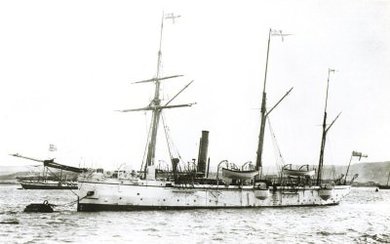 HMS Bramble mpl3094 1886 image flipped for comparison
HMS Bramble mpl3094 1886 image flipped for comparison
Dressing the ship in the RN is usually only done for visiting royalty - they might have so honoured Kitchener of Khartoum aboard HMS Encounter but that was 1910 - this is a composite gunboat possibly HMS Bramble which was with Owen Stanley and HMS Rattlesnake which rescued the Scot Barbara Thomson after being the sole survivor of the wreck of their cutter America & nearly 5 years as the wife of a tribesman called Boroto who called her Gi'om as he took her for the reincarnated spirit of his daughter but that was in 1849.
'During the stay of the Rattlesnake at Cape York a remarkable incident took place. On October 16, 1849, a white woman claimed the protection of a boat's crew who had landed on the beach. She was Barbara Thomson, a native of Aberdeen (Scotland), who had emigrated with her parents to New South Wales, where she had married. Some four and a half years previously (in 1845) she had embarked with her husband in the cutter America, bent on the salvage of oil from a whaler wrecked on Brampton Shoal.
The guide, a member of the shipwrecked crew, failed to discover the wreck, whereupon recrimination and quarrelling ensued. Two men were accidentally drowned and a third was left on a small uninhabited island. Then the America made for Torres Strait, and was wrecked on Entrance Island.
The only two men then on the ship (one of them Barbara's husband) were drowned in the attempt to swim ashore; but the woman was rescued by the natives, one of whom, named Boroto, took her to wife, and she enjoyed the protection of a person of importance in the tribe, who lived on Prince of Wales Island and who recognised her as the re-embodied spirit of his deceased daughter who had been named Gi'om, which name was conferred on her.
A year previously, the people of the island had heard of the visit of two war canoes—no doubt the Rattlesnake and Bramble—to Cape York. Recently, when the smoke-telegraph conveyed the news of the return of the two ships, Gi'om had persuaded her hosts, chiefly by hints of great rewards, to take her to Cape York. Once safely on board the Rattlesnake and, in spite of objections and threats on the part of her black friends (who seemed to have become genuinely attached to her) she elected to return to Sydney, where she was ultimately restored to her parents.'
'During the stay of the Rattlesnake at Cape York a remarkable incident took place. On October 16, 1849, a white woman claimed the protection of a boat's crew who had landed on the beach. She was Barbara Thomson, a native of Aberdeen (Scotland), who had emigrated with her parents to New South Wales, where she had married. Some four and a half years previously (in 1845) she had embarked with her husband in the cutter America, bent on the salvage of oil from a whaler wrecked on Brampton Shoal.
The guide, a member of the shipwrecked crew, failed to discover the wreck, whereupon recrimination and quarrelling ensued. Two men were accidentally drowned and a third was left on a small uninhabited island. Then the America made for Torres Strait, and was wrecked on Entrance Island.
The only two men then on the ship (one of them Barbara's husband) were drowned in the attempt to swim ashore; but the woman was rescued by the natives, one of whom, named Boroto, took her to wife, and she enjoyed the protection of a person of importance in the tribe, who lived on Prince of Wales Island and who recognised her as the re-embodied spirit of his deceased daughter who had been named Gi'om, which name was conferred on her.
A year previously, the people of the island had heard of the visit of two war canoes—no doubt the Rattlesnake and Bramble—to Cape York. Recently, when the smoke-telegraph conveyed the news of the return of the two ships, Gi'om had persuaded her hosts, chiefly by hints of great rewards, to take her to Cape York. Once safely on board the Rattlesnake and, in spite of objections and threats on the part of her black friends (who seemed to have become genuinely attached to her) she elected to return to Sydney, where she was ultimately restored to her parents.'
Unloading at Gulnare Jetty below Fort Hill inside Kitchener Bay with Stokes Hill to the right. Funnel is similar to the ship below which is unloading a boat that is the focus of interest. The funnel colouring may denote a shipping line with a dark top to increase draw. Perhaps they are waiting for the tide to drop then move the ship out to allow the boat to be lowered into the water - hence the air of 'those who 'also serve'. No record of a coastal vessel called the SS Port Darwin has yet come to light.
Petrel survived 1887 pearling fleet disaster
Lugger Ena struck a reef near Port Essington, NT, 11 April 1937. Crew of six rescued by the lugger Petrel.
Mr. V. J. Clark, Darwin’s biggest pearler had a supply schooner, Petrel in Dec 1933,
Lugger Ena struck a reef near Port Essington, NT, 11 April 1937. Crew of six rescued by the lugger Petrel.
Mr. V. J. Clark, Darwin’s biggest pearler had a supply schooner, Petrel in Dec 1933,
These Bleeser images show Palmerston (1864-1866) at Escape Cliffs in Adam Bay - at the mouth of the Adelaide River - South Australia's first attempt at a Capital for its Northern Territory and the promise of land sale revenue. The image at left is another view of the same clump of trees except that it is taken from the other side of the water tanks. These unique images are indicative of the problem - decades out of copyright but owned & uncleaned copies sold by both the SLSA & NLA. It is a crime to disfigure images by puerile & idiotic notations for cataloguing purposes. These are SA/NT relics, as with all artefact management, they should be assembled as complete collections - researched, described, managed and conserved in the place where they have most meaning - by the people for whom they have most meaning and displayed for the self-esteem of that society - the education of its children and engagement of guests - not rendered useless & undiscoverable by institutions paid to do exactly the opposite.
Bleeser's photographic work is even more obscure than his botanical achievements but therein he is known for his images of Darwin either side of the great cyclone which began on the evening of the 6th January 1897, reaching crescendo between 3.30am and 4.30am on 7 January. Bleeser was just 26 years old but he already displays a mastery of the technical and artistic challenges of photography in the remote tropics, as well as a fine appreciation of the medium's value as an analytical tool in the documentation of great events.
J. J. McInerney
Unattributed
Jetty, Port Darwin. Length of approach of the "T" shaped jetty is 418 feet, length of head is 558 feet, depth at low water is 23-28 feet, rise of the tide is 25 feet. A large steam boat is tied up at the jetty


